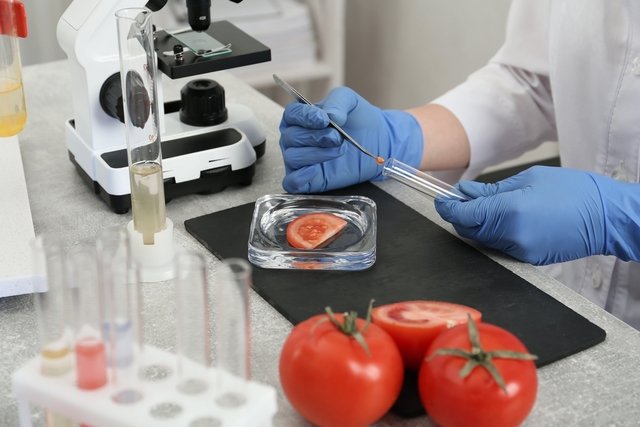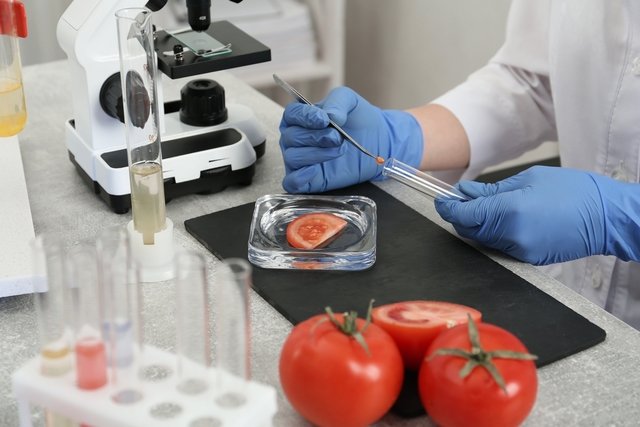Transgenic foods, also known as genetically modified foods, are those that have parts of DNA from other living organisms mixed, through genetic engineering, with their own DNA.
Genetic modification of certain foods is done with the aim of increasing their resistance against pests, insects and drought, improving nutritional quality and facilitating food cultivation. Some plants contain the DNA of bacteria that produce natural herbicides, helping to combat pests in crops, for example.
However, some studies (1), (2)indicate that transgenic foods may present some health risks, such as increasing the occurrence of allergies and increasing the consumption of pesticides, chemicals that are used in agriculture to kill or prevent the appearance of insects, larvae and fungi. Learn more about pesticides.

Why are they produced
The main objectives with the production of transgenic foods are:
- Improve the final product, with a greater amount of nutrients, better flavor or appearance of food;
- Increase resistance to pests and drought, reducing the need for the use of pesticides and losses during food cultivation;
- Increase production and the storage time of food;
- Reduce the price, improving food accessibility.
However, to produce transgenic foods, producers need to buy seeds from genetic engineering companies and, therefore, the value of the transgenic product to the consumer can be the same as the conventional one.
What are transgenic foods
The main transgenic foods sold in the world are soy, corn and cotton, which give rise to products such as soy oil, soy extract, textured soy protein, soy milk, sausage, margarine, bread, cakes and cookies. .
In addition, foods that contain corn starch, corn syrup and soy in their composition may also contain GMOs.
According to Brazilian legislation, the label of foods containing transgenic components must contain the transgenic identification symbol, which is represented by a yellow triangle with a “T” in the middle.
Possible health risks
Prolonged consumption of transgenic foods may increase the risk of some health problems, including:
- Promote allergic reactions, because they contain genes that may be foreign to the organism, generating an exaggerated reaction from the immune system;
- Increase antibiotic resistance, as transgenic foods may contain antibiotic-resistant genes, which are transferred to cells and the gastrointestinal tract, reducing the effectiveness of these medicines in treating bacterial infections;
- Increase the consumption of pesticides, because many weeds, which are plants that hinder the cultivation of food, have also become resistant to pesticides, increasing the need to apply greater quantities of these products to the plantation to combat them.
Despite the possible health risks of consuming GM foods, current studies are still inconclusive. This is because there are no evaluations carried out over long periods of time on the health impacts of GMOs.
Possible damage to the environment
The production of GM foods also increases weed resistance. Therefore, to combat weeds, it is normally necessary to apply greater quantities of pesticides to the plantation, increasing the risk of contamination of food, soil and water.
Furthermore, the high use of pesticides can also cause the death of species essential for food production, such as bees, earthworms and other plants, and encourage the emergence of other weeds and pests that are more resistant to these substances, making it difficult to control pesticides. plantation quality.
Bibliography
- WOLRD HEALTH ORGANIZATION. Food, genetically modified. Disponível em: <https://www.who.int/news-room/questions-and-answers/item/food-genetically-modified>. Acesso em 20 jan 2023
- FIOCRUZ. Dossier signals link between GMOs and increased use of pesticides. Available at: <https://portal.fiocruz.br/noticia/dossie-sinaliza-ligacao-entre-transgenicos-e-aumento-do-uso-de-agrotoxicos>. Accessed on January 20, 2023
- DUNN, A, Eliza et al. The allergenicity of genetically modified foods from genetically engineered crops: A narrative and systematic review. Annals of Allergy, Asthma and Immunology. Vol.119. 3.ed; 214-222, 2017
- SCHUTTE, Gesine et al. Herbicide resistance and biodiversity: agronomic and environmental aspects of genetically modified herbicide-resistant plants. Environmental Sciences Europe. Vol.29. 1.ed; 2017
- SILVA, S, Mariana et al. Transgenic foods and food and nutritional security in Brazil. Brazilian Journal of Health Review. Vol.3. 5.ed; 11901-11923, 2020
- HILBECK, Angelika et al. No scientific consensus on GMO safety. Environmental Sciences Europe. Vol.27. 4-ed; 1-6, 2015
- WHO. Questions and answers: Food, genetically modified. Disponível em: <https://www.who.int/news-room/questions-and-answers/item/food-genetically-modified>. Acesso em 18 jan 2022

Sign up for our newsletter and stay up to date with exclusive news
that can transform your routine!
Warning: Undefined array key "title" in /home/storelat/public_html/wp-content/plugins/link-whisper-premium/templates/frontend/related-posts.php on line 12
Warning: Undefined array key "title_tag" in /home/storelat/public_html/wp-content/plugins/link-whisper-premium/templates/frontend/related-posts.php on line 13





